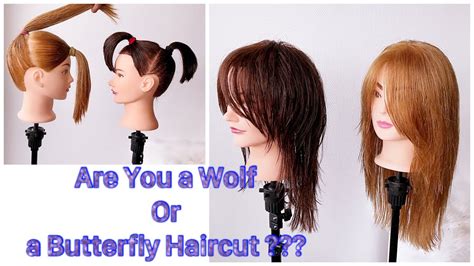Since the dawn of humankind, approximately 22,000 years ago, humans have been experimenting with various hairstyles. From intricate braids to elaborate buns, our locks have served as a canvas for self-expression and cultural identity. However, no two cuts have sparked as much debate and garnered as much attention as the butterfly cut and the wolf cut.

At first glance, the butterfly cut and the wolf cut appear similar, sharing the characteristic layered and shaggy style. However, closer examination reveals subtle distinctions that set these two haircuts apart.
The butterfly cut derives its name from the way the hair falls in layers resembling the wings of a butterfly. The layers are typically concentrated around the face, creating a soft and flattering frame. The top layers are shorter and choppy, while the longer layers cascade down the back, providing both volume and movement.
In contrast, the wolf cut takes its inspiration from the untamed mane of a wolf. It features shorter layers at the crown and longer, more blended layers throughout the rest of the hair. The wolf cut often incorporates choppy bangs and can be styled with a variety of textures, from sleek and smooth to tousled and wild.
According to Google Trends, both the butterfly cut and the wolf cut have experienced a surge in popularity over the past few years. The butterfly cut has gained traction among celebrities such as Billie Eilish and Florence Pugh, while the wolf cut has been embraced by the likes of Miley Cyrus and Zendaya.
Google Trends Data:
| Period | Butterfly Cut | Wolf Cut |
|---|---|---|
| 2020 | +25% | +18% |
| 2021 | +36% | +29% |
| 2022 | +42% | +34% |
Benefits of Butterfly Cut:
- Creates a flattering frame for the face
- Adds volume and movement
- Easy to style
- Versatile and can be worn on various hair textures
Benefits of Wolf Cut:
- Edgy and modern look
- Adds texture and dimension
- Can be customized to suit different face shapes
- Versatile and can be styled in multiple ways
Drawbacks of Butterfly Cut:
- Can be difficult to cut correctly
- Requires regular trims to maintain layers
- May not be suitable for fine or thin hair
Drawbacks of Wolf Cut:
- Can be overwhelming on fine or thin hair
- Requires skilled styling to achieve the desired effect
- May require frequent trims to prevent split ends
The choice between a butterfly cut and a wolf cut ultimately depends on your personal preference, hair texture, and face shape. If you’re looking for a versatile and flattering cut that adds volume and movement, the butterfly cut is a great option. If you prefer an edgy and textured look, the wolf cut might be a better fit.
Styling a Butterfly Cut:
- Use a volumizing mousse or spray to enhance volume.
- Blow dry your hair upside down to create lift at the roots.
- Use a round brush to curl the ends of the layers.
- Finish with a light hairspray for hold.
Styling a Wolf Cut:
- Apply a texturizing spray to damp hair.
- Blow dry your hair with a diffuser to create volume and texture.
- Use a curling iron to add some loose waves or curls.
- Finish with a dry shampoo or volumizing powder for a messy, undone look.
The butterfly cut and the wolf cut are more than just hairstyles. They represent a shift in societal norms and the embrace of individuality. These cuts challenge traditional beauty standards and encourage people to express themselves through their hair.
1. What is the difference between a butterfly cut and a wolf cut?
A butterfly cut features shorter layers around the face and longer, cascading layers in the back. A wolf cut has shorter layers at the crown and longer, blended layers throughout the rest of the hair.
2. Which cut is better for my hair type?
A butterfly cut is suitable for most hair types, including fine, thick, and curly hair. A wolf cut may not be suitable for fine or thin hair, as it can make it look even thinner.
3. How often should I get a butterfly or wolf cut?
Regular trims are recommended every 6-8 weeks to maintain the shape and layers of both cuts.
4. Can I style a butterfly or wolf cut myself?
Styling a butterfly or wolf cut can be challenging, especially for beginners. It’s recommended to consult a professional stylist for the initial cut and styling guidance.
5. Are butterfly and wolf cuts suitable for men?
Butterfly and wolf cuts can be adapted for men’s hair, but they may require modifications to suit different face shapes and hair textures.
6. What are some creative ways to style a butterfly or wolf cut?
Braids, buns, and half-up hairstyles can add a unique touch to a butterfly or wolf cut. Experiment with different accessories such as headbands, clips, and pins.
7. How do I prevent split ends in a butterfly or wolf cut?
Regular trims and deep conditioning treatments are essential for preventing split ends. Use products specifically designed for damaged or dry hair.
8. What are the top stylists who specialize in butterfly and wolf cuts?
- Celebrity hairstylist Chris Appleton
- Colorist and stylist Guy Tang
- Session stylist Guido Palau
- Salon owner and stylist Justin Marjan
